Trifluoperazine dihydrochloride
Synonym(s):10-[3-(4-Methylpiperazin-1-yl)propyl]-2-(trifluoromethyl)-10H-phenothiazine dihydrochloride;Trifluoperazine dihydrochloride
- CAS NO.:440-17-5
- Empirical Formula: C21H26Cl2F3N3S
- Molecular Weight: 480.42
- MDL number: MFCD00012656
- EINECS: 207-123-0
- SAFETY DATA SHEET (SDS)
- Update Date: 2025-12-23 21:30:31
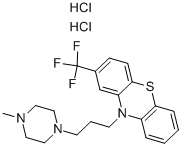
What is Trifluoperazine dihydrochloride?
Description
Trifluoperazine (TFP) is a phenothiazine compound with anti-
Chemical properties
Cream Fine Powder
Originator
Stelazine,SKF,US,1958
The Uses of Trifluoperazine dihydrochloride
Trifluoperazine dihydrochloride has been used as a calmodulin kinase antagonist in cultured Aplysia californica neurons. Trifluoperazine dihydrochloride has also been used as a PMCA inhibitor in mouse duodenal tissues to block the transcellular active calcium flux.
The Uses of Trifluoperazine dihydrochloride
Antipsychotic
What are the applications of Application
Trifluoperazine Dihydrochloride is an antiadrenergic and antidopaminergic
Manufacturing Process
A mixture of 17.2 grams of 2-trifluoromethylphenothiazine, 3.1 grams of sodamide and 14 grams of 1-(3'-chloropropyl)-4-methylpiperazine in 200 ml of xylene is heated at reflux for 2 hours. The salts are extracted into 150 ml of water. The xylene layer is then extracted with several portions of dilute hydrochloric acid. The acid extracts are combined and neutralized with ammonium hydroxide solution. The product, 10-[3'-(4''-methyl-1''- piperazinyl)-propyl]-2-trifluoromethylphenothiazine, is taken into benzene and purified by vacuum distillation, BP 202° to 210°C at 0.6 mm.
Therapeutic Function
Tranquilizer
General Description
Trifluoperazinehydrochloride, 10-[3-(4-Methyl-1-piperazinyl)propyl-[2-(trifluoromethyl)phenothiazine dihydrochloride (Stelazine).The absorption of trifluoperazine is erratic and variable andit is widely distributed into tissues. The excretion of trifluoperazineoccurs 50% via kidneys and the other 50% isthrough enterohepatic circulation. The metabolism and druginteractions of trifluoperazine are the same as with the otherphenothiazines. Trifluoperazine does not show any specificdrug interactions. Trifluoperazine is indicated for the managementof schizophrenia and short-term treatment ofnonpsychotic anxiety.
Biochem/physiol Actions
Trifluoperazine dihydrochloride is useful in treating schizophrenia, disturbed behavior, severe anxiety, nausea and vomiting.
Safety Profile
Poison by intravenous and intraperitoneal routes. Moderately toxic by ingestion. Experimental reproductive effects. Human mutation data reported. When heated to decomposition it emits very toxic fumes of F-, NOx, SOx, and HCl. See also FLUORIDES.
Purification Methods
Recrystallise the salt from absolute EtOH, filter the crystals, dry them in vacuo and store them in tightly stoppered bottles because it is hygroscopic. It is soluble in H2O but insoluble in *C6H6, Et2O and alkaline aqueous solution. It has UV at 258 and 307.5nm (log 4.50 and 3.50) in EtOH (neutral species). [Craig max et al. J Org Chem 22 709 1957.] It is a calmodulin inhibitor [Levene & Weiss J Parmacol Exptl Ther 208 454 1978] and is a psychotropic agent [Fowler Arzneim.-Forsch 27 866 1977]. [Beilstein 27 III/IV 1353.]
Properties of Trifluoperazine dihydrochloride
| Melting point: | 243 °C (dec.)(lit.) |
| Flash point: | 9℃ |
| storage temp. | -20°C |
| solubility | ethanol: soluble5mg/mL |
| form | powder |
| pka | pK1 3.9, pK2 8.1(at 25℃) |
| color | white to off-white |
| λmax | 312nm(MeOH)(lit.) |
| Merck | 14,9680 |
| BRN | 3820024 |
| Stability: | Hygroscopic |
| CAS DataBase Reference | 440-17-5(CAS DataBase Reference) |
| EPA Substance Registry System | 10H-Phenothiazine, 10-[3-(4-methyl-1-piperazinyl)propyl]-2-(trifluoromethyl)-, dihydrochloride (440-17-5) |
Safety information for Trifluoperazine dihydrochloride
| Signal word | Danger |
| Pictogram(s) |
 Exclamation Mark Irritant GHS07  Health Hazard GHS08  Environment GHS09 |
| GHS Hazard Statements |
H302:Acute toxicity,oral H319:Serious eye damage/eye irritation H336:Specific target organ toxicity,single exposure; Narcotic effects H341:Germ cell mutagenicity H372:Specific target organ toxicity, repeated exposure H410:Hazardous to the aquatic environment, long-term hazard |
| Precautionary Statement Codes |
P201:Obtain special instructions before use. P273:Avoid release to the environment. P305+P351+P338:IF IN EYES: Rinse cautiously with water for several minutes. Remove contact lenses, if present and easy to do. Continuerinsing. P308+P313:IF exposed or concerned: Get medical advice/attention. |
Computed Descriptors for Trifluoperazine dihydrochloride
New Products
4,4-Difluoropiperidine hydrochloride tert-butyl 9-methoxy-3-azaspiro[5.5]undecane-3-carboxylate Indole Methyl Resin N-Isopropylurea N,N-Dicyclohexylcarbodiimide(DCC) MELDRUMS ACID 5-METHYLISOXAZOLE-4-CARBOXYLIC ACID Magnessium Bis glycinate Zinc ascorbate 1-bromo-2-butyne 2-acetamidophenol 9(10H)-anthracenone Erythrosin B, 4-Piperidinopiperidine 2-((4-morpholinophenylamino) (methylthio) methylene) malononitrile 2,4-dihydroxybenzaldehyde 3-(4-morpholinophenylamino)-5-amino-1H-pyrazole-4-carbonitrile Methyl 2-methylquinoline-6-carboxylate 2,6-dichloro-4-nitropyridine 4-Bromo-2-chlorobenzonitrile 2-(benzylamino)acetic acid hydrochloride 4-(tert-Butoxycarbonylamino)but- 2-ynoic acid 3,4-dihydro-2H-benzo[b][1,4]dioxepine 1-Phenyl-1-cycloprppanecarboxylicacidRelated products of tetrahydrofuran
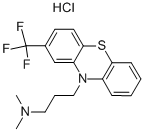
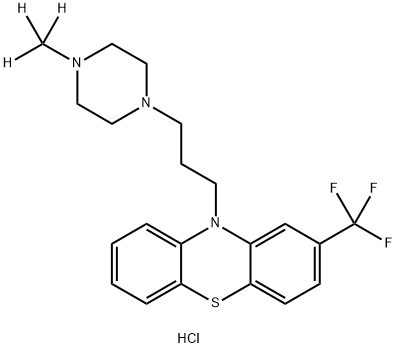
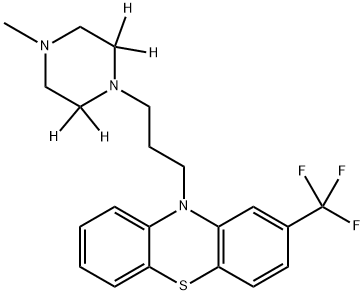
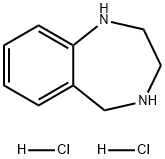


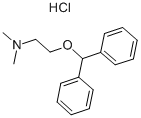
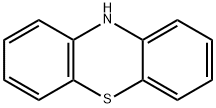
You may like
-
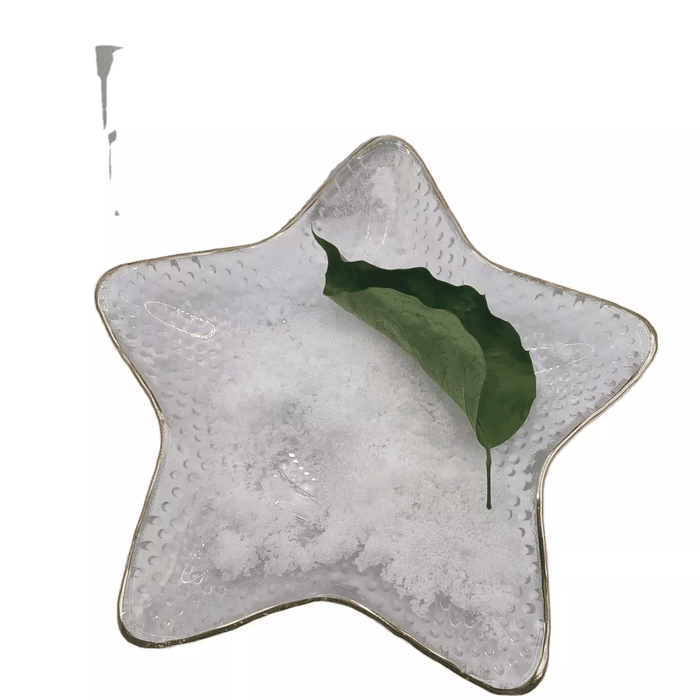 440-17-5 TRIFLUOPERAZINE HCL IP/BP/USP 98%View Details
440-17-5 TRIFLUOPERAZINE HCL IP/BP/USP 98%View Details
440-17-5 -
 Trifluoperazine dihydrochloride 440-17-5 98%View Details
Trifluoperazine dihydrochloride 440-17-5 98%View Details
440-17-5 -
 Trifluoperazine Dihydrochloride CAS 440-17-5View Details
Trifluoperazine Dihydrochloride CAS 440-17-5View Details
440-17-5 -
 Trifluroperazine dihydrochloride 95.00% CAS 440-17-5View Details
Trifluroperazine dihydrochloride 95.00% CAS 440-17-5View Details
440-17-5 -
 Trifluroperazine dihydrochloride 99% (HPLC) CAS 440-17-5View Details
Trifluroperazine dihydrochloride 99% (HPLC) CAS 440-17-5View Details
440-17-5 -
 Trifluroperazine dihydrochloride 98% (HPLC) CAS 440-17-5View Details
Trifluroperazine dihydrochloride 98% (HPLC) CAS 440-17-5View Details
440-17-5 -
 Trifluoperazine hydrochloride CAS 440-17-5View Details
Trifluoperazine hydrochloride CAS 440-17-5View Details
440-17-5 -
 20677-73-0 (2,2-diethoxyethyl)methylamine 98%View Details
20677-73-0 (2,2-diethoxyethyl)methylamine 98%View Details
20677-73-0
